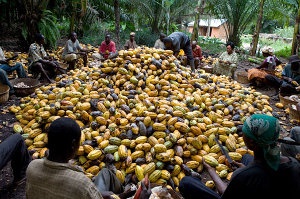... Cote d’Ivoire, Indonesia ranked higher
Cocoa productivity in Ghana, the world’s number-two grower, is far below levels in top-grower Cote d’Ivoire and third-largest Indonesia.
While Ghana produces only 400 kilos of cocoa beans from a hectare of cocoa farm, Cote d’Ivoire the biggest producer does 600 kilogrammes per hectare, and Indonesia the biggest producers per hectare does 1,000 kg/h.
Ghana’s low productivity is a result of depleting soil nutrients, deforestation, low income for smallholder cocoa farmers and other challenges. All this has played a big part in the country’s uncompetitiveness on the global market.
Managing Director of Solidaridad West Africa, Mr. Isaac Gyamfi, said this in Accra when the company signed a 7 million euro grant with the Netherlands Embassy to implement the Cocoa Rehabilitation and Intensification Programme (CORIP) over the next four years.
Solidaridad West Africa is a not-for-profit organisation that supports sustainable development of farmers and production systems in West Africa through the enhancement of value chains of fresh and processed agricultural commodities and other non-agricultural commodities.
Mr. Gyamfi said most of the crop farms need to be rehabilitated to increase productivity that would ultimately improve the country’s competitiveness on the global market; adding “our competitors in other parts of the world are doing over 1,000 kg per hectare while we are doing 400 kilos and sometimes even less.”
Commenting of the benefit of the grant, he explained that the funding is expected to leverage an additional private sector cocoa industry facility of 14 million euros.
He said the Dutch government’s support aims at developing economic, social and environmentally sustainable support for cocoa farmers in the main cocoa producing regions of the country.
“The grant will provide the necessary technical support for farmers to rehabilitate old farms and intensify existing cocoa systems. It will work with the Cocoa Research Institute of Ghana and Ghana Cocoa Board to boost availability of improved planting materials for the farmers.
“The programme will target entrepreneurial farmers who really want to develop their cocoa farms into sustainable and viable business enterprises.”
Mr. Gyamfi added that the CORIP will promote the establishment and operation of cocoa Rural Service Centres (RSCs), accentuating the need to increase cocoa production in a sustainable self-financing way.
“The RSCs will be privately run entities that provide training, information, inputs and other technical support for improved cocoa production,” he stated.
The Dutch Ambassador to Ghana, Hans Docter, said: “The programme is a good example of current Dutch policy of combining trade and development cooperation.
“The programme shows that public and private interests can go hand in hand to add value, without the government having to take on additional burdens to increase export revenue, make production more sustainable, and improve farmer’s profits,” he said.
The Netherlands is the largest importer of cocoa from West Africa. Ghana is the second-largest producer of cocoa in the world, with total bean sales averaging US$2billion per annum.
The project is managed and coordinated by Solidaridad West Africa and was jointly developed by a consortium of cocoa sector partners and industry companies, including International Fertiliser Development Corporation (IFDC); Armajaro, Cargil;, ECOM; Barry Callebaut; ADM; and Continaf -- with the expectation that more cocoa companies will participate in its implementation.
The country opened the 2013/14 crop on October 18 with an initial target of buying around 830,000 tonnes.
It runs a two-cycle cocoa season consisting of the October-June main crop harvest which is mainly exported, and the July-September light crop that is discounted to local grinders.
The country produced 835,410 tonnes of cocoa during the 2012/13 crop year, down 5 percent on the previous season, cumulative provisional data from industry regulator Cocobod showed.
An unprecedented one million tonnes of cocoa was produced during the 2010/11crop-year, thanks to good weather and improved farming techniques -- but production declined to about 850,000 tonnes in the 2011/12 season. Cocobod said cocoa production tends to fall slightly after a bumper year.
Business News of Friday, 13 December 2013
Source: B&FT

















